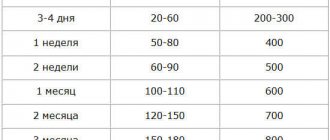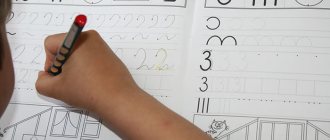Typically, children learn to count to three and then to ten quite early, but remembering what the numbers look like, much less reproducing them on paper, is a more difficult task. Knowing how to name and write numbers is just as important as the letters of the alphabet. These are the building blocks from which a child’s ability to read and write is built. There are special techniques for learning numbers that will help your child remember this material in a short time.
How to teach a child to write numbers
To teach a child to write numbers, you need to understand how to teach a child to remember numbers. Children perceive a number as a whole; it is difficult for them to separate it into individual components. This is exactly what you need to teach your child if you want him to write numbers beautifully and accurately. Therefore, when writing, explain to your child how individual parts are written. You need to focus on the main part of the number, its tail.
An important point is working with the cell. You should first teach your child how to work with cells. The baby must be well versed in the arrangement of the elements of the cage. This is necessary to teach your child to write numbers. Student notebooks are marked in a cage, so these skills will be useful to the child in the future, and not just for learning to write numbers.
Learning by association
Abstract numbers mean nothing to a child; for this reason, visual representations are the best way to help children remember certain numbers with ease. For example, a baby’s mother can compare the number 2 with the figure of a swan, 0 with the letter O or a circle, 8 with a matryoshka, etc.
There are several types of associative methods:
- The hanger method helps children remember certain numbers by assigning each number a visual image or a specific word (for example, 1 is an athlete, 5 is an image of a school, 15 is an athlete participating in school competitions).
- Comparing numbers with a specific image - 0 looks like a ball, a sun, a circle; 1 is a toothpick, straw, flashlight, etc.
- O'Brien's method - connecting numbers with the names of famous people. The main principle of the association is number – person – action. For example, 1 is Agnia Barto, 5 is a writer, and already the number 15 is a person who writes poetry.
- Rhymes are combinations of numbers with a certain consonance of words or rhymes.
The child should be taught one associative technique that seems most convenient and easy to remember for an adult. Otherwise, the student will get confused in a large number of difficult-to-understand techniques for memorizing images.
What skills are needed?
The optimal solution would be to print an enlarged cell layout. This way, the baby will be able to quickly master working with the cage. That is, you need a rectangle, the main thing is that the proportions of the cell are respected. A large cage will help teach your child to write numbers. It is necessary to use a large cage at least at the initial stage of study.
You can also purchase a suitable manual to teach your child to write numbers. Today the market offers many options from different authors. Some are even sold with special markers that can be washed off if necessary. The following exercises are worth doing:
- Teach your child to identify the right and left sides of the cage. Also show that it has a lower and an upper bound. This will greatly simplify the learning process, and you can easily teach your child to write numbers.
- Show that when writing numbers you will have to maintain a certain slant. To do this, you need to show your child how to do the bend in general. You can draw a segment from the upper right corner to the middle of the lower edge.
- The baby must quickly find the center of the cage, its corners, as well as the middle of all sides.
- Teach your child to divide the cage into four equal parts.
Game of speed
You will need a deck of 10 cards for each player. You can make them yourself. The cards must have numbers drawn on them (from 1 to 10). Each player must shuffle their deck and place it face up in the stack. Then, at the command of an adult, children should begin to sort their cards, placing them in the correct sequence. The first player to get it right wins. But don't stop the game there. All players must finish laying out their cards. This game can be played several times in a row to help your children develop more effective sorting and organizing strategies. You could even have your child play the game themselves - just time the time it takes them to complete the task.
How to choose a copybook
A copybook for a child is the best solution if you want to teach him to write numbers. A specially selected copybook will help not only master numbers, but also prepare your hand for writing. It is necessary to select educational materials according to age. When choosing a recipe you need to be extremely careful:
- The numbers in bold should come first. They will play the role of a model that the baby will focus on.
- Behind the highlighted characters there should be 2 or 3 more characters printed with dots or in a light shade.
- There may also be numbers in bold in the middle of the line. They will also act as guides if you decide to teach your child to write numbers.
Connect numbered cards until you go through the entire deck
Take the numbered cards. Have your child turn over the first card in the deck. Then ask to turn over the next card. If its number matches the number of the first card, they need to be placed next to each other, if not, put aside. For this game, you can use a deck of regular playing cards, taking out cards with pictures.
The money tree pleases with lush flowering: my secret is in caring for the leaves
“We are still friends”: Derevianko commented on the breakup with his wife
Lost weight: what Sofia Tarasova sacrificed for the sake of “VIA Gra” (new photos)
How to teach a child numbers at 3 years old
If you are thinking about how to teach your child numbers, then you should take into account age characteristics. 3-year-old children cannot spend much time studying, especially not in the form of play. That is why they should be given special attention if you want to teach your child to write numbers. It is difficult to captivate a child for a long time; this is an age-related feature. Teaching a child to write numbers at this age requires patience and love from parents. You need to follow simple tips:
- To teach a child numbers, you need to build learning in a playful way.
- Try to get your baby to remember the numbers by ear, pay attention to them everywhere. This is necessary in order to teach your child to write numbers.
- Adapt to your baby; don’t force him to do something he doesn’t want.
- You need to devote as much time to classes as the baby can sit at the table. It could be 5, 10, 20 minutes. You need to focus specifically on the child’s capabilities; this time will be enough to teach the child to write numbers.
- If you are working with a child, teaching him to write numbers, then after class, devote time to your favorite activity. For example, let your baby play with a tablet.
- It is not necessary to study at the table; you can make lessons more active and dynamic.
- Do not leave completed tasks unattended to stimulate your baby. To teach a child to write numbers, you need to check assignments and praise the baby for the work done.
Number recognition practice with games and activities
For the first game you will need 1 die, a piece of paper, pencils, 6 tokens per player and a number line from 1 to 6 for each player. One player rolls the die and places a token on that number on their number line. The other player does the same. If any player rolls a number that is already covered by a token, he misses his turn. The first one to occupy all 6 numbers wins the game. You can also use a number line from 1 to 12 for older children and roll two dice instead of one.
How to teach a child numbers at 4 years old
If you are interested in the question of how to teach a child to write numbers at 4-5 years old, then you should follow some tips:
- Each figure studied must be supported by the number of certain items. That is, the baby must learn that the number corresponds to the number of cars, sweets, and cubes in the box. This is the most important thing you need to convey to your baby in order to teach him to write numbers. To do this, use any objects during classes. Let your child learn to count them, and then you can teach him to write numbers. It will be pointless to teach a child to write numbers if he does not understand what they mean. First we teach counting, then we show the child a number; it can be a plastic figure or a cut-out number from paper. This will help you remember the shape and distinguish one number from others. After this, you can teach your child to write numbers
- If you are thinking about how to teach a child numbers at 5 years old, then keep in mind that you will have to repeat a lot. To teach your child to write numbers, teach him to count. To do this, name them on the street, in newspapers, books. Count the steps; you can purchase a special set of plastic numbers. If you realize that your child is good at counting, you can teach your child to write numbers and introduce him to more complex numbers.
- You can use a game to teach your child to write numbers. Find memorable counting rhymes up to 10. Don’t be afraid, the memory of a child aged 4-5 years is especially flexible, he can easily remember the counting rhyme. This will make teaching your child to write numbers much easier.
What is needed for a successful result
There are a number of factors that can affect the result:
- student interest;
- the right time and place for classes;
- consistency in the actions of the parent;
- kindness on the part of adults.
Child's interest
Introducing numbers should begin when the student has shown curiosity. There is no point in teaching earlier. If you rush too much, children may lose the desire to learn numbers for a long time. The process can become stressful for them, which makes learning difficult and may cause problems with mathematics in the future.
Good place
To study, you need a place where there will not be too many distractions. If there are toys nearby, it will be difficult for the child to concentrate. The selected location should be well lit.
Correct duration
You should not arrange too long classes for preschoolers. They will quickly get tired, which will lead to a decrease in attentiveness and concentration on the process. Studying for too long can cause you to develop an aversion to studying or math. The duration must be selected taking into account age and individual characteristics.
Parent sequence
You need to gradually increase the complexity of the tasks. In addition, it is necessary to remain calm, even if something does not work out for a preschooler for a long time. Anger and aggression on the part of an adult can frighten, which will lead to attempts to avoid studying. It is recommended to praise children even for small successes in order to motivate them to continue studying.
Print and teach children to write numbers
Digit 1
Teach your child to write the number 1 (one). Just print and practice with your child.
- To teach your child to write numbers, mark a point in the middle of the cell slightly above its center. Connect the dot to the upper right corner.
- Connect the right corner of the cell with the point located at the bottom in the middle of the line.
Digit 2
Teach your child to write the number 2 (two). Just print and practice with your child.
- To teach your child to write numbers, draw a small semi-oval in the upper right half of the cell.
- Extend the semi-oval by drawing a straight line in the middle of the lower edge.
- Draw a wavy line at the bottom, which consists of three waves.
Digit 3
Teach your child to write the number 3 (three). Just print and practice with your child.
- To teach your child to write numbers, draw a small semi-oval at the top of the cell, round it, it should not reach the visual center a little.
- Move on to the second semi-oval, it should be larger.
Digit 4
Teach your child to write the number 4 (four). Just print and practice with your child.
- The first point should be placed to the right of the center of the upper edge, draw a line to the middle. You need to bring it to a point that is slightly below the center, the line should go at an angle. We turn the line, lead it to the right, you need to stop before reaching the right side.
- The line is drawn from the top right side down. It should be located parallel to the existing line.
Number 5
Teach your child to write the number 5 (five). Just print and practice with your child.
- To teach a child to write numbers, first write with a small stick, you need to make a slight tilt. It visually divides the cell in half.
- We draw a semi-oval, rounding it up, then to the right. It should touch the right side of the cage line. The semi-oval should end, rising just above the middle of the bottom edge.
- Draw the top ponytail. You need to start from the point where you started drawing the top stick.
Number 6
Teach your child to write the number 6 (six). Just print and practice with your child.
- To teach a child to write numbers, you need to take into account that the child must learn to write this number so that it is shifted to the left side of the notch.
- You need to start from the top, take a point approximately in the middle of the upper edge. We go down a little, gradually the line should move to the lower left corner.
- The oval needs to be rounded, rising from the middle to the central part.
Number 7
Teach your child to write the number 7 (seven). Just print and practice with your child.
- The point should be slightly below the middle of the top line. A wavy line is drawn along the line. You need to stop in the upper right corner.
- There is no need to lift the pen from the paper; a vertical line is drawn down to the bottom border. It should go to the center of the bottom line.
- We tear the pen off the paper to draw a small stick in the middle. Visually, it divides the cell in half.
Number 8
Teach your child to write the number 8 (eight). Just print and practice with your child.
- First, the upper oval is drawn, the dot is placed in the middle of the cell, a little closer to the right edge. We draw an oval almost in the shape of a drop; we need to return to the point from which we started.
- The lower oval needs to be created by moving down to the left. Again we draw a drop-shaped oval.
Number 9
Teach your child to write the number 9 (nine). Just print and practice with your child.
- First, draw the upper part; you need to place a point slightly below the upper corner. The line goes down, left, up. The result is a small oval sloping to the right.
- From the point from which we started drawing the oval, we lower the line down, rounding it. The tail should rise slightly above the bottom rib.
Adding numbers to sensory play
Buy sets of magnetic numbers and have your child match them. Let your child play with them freely at first so that they begin to recognize the shapes of different numbers. Then ask him to match pairs or groups with the same number. If the child is older, see if he can put the numbers in order. Magnetic numbers can be attached to the refrigerator door or to a baking sheet.
Tower of blocks
The essence of the game is that you need to roll the dice, then build a tower of blocks using the number of points rolled. Choose a die with symbols on the side rather than dots. Make this game more challenging by taking turns and adding to your tower each turn until you get to 10. For example, your child rolls a "2" and builds a tower with 2 blocks. You roll a "4" and stack 4 blocks to create your tower. Your child rolls again and gets a "6". He then counts out 6 additional blocks to add to his original tower for a total of 8 blocks. Keep playing until both of your towers are 10 blocks high.
Found a violation? Report content









